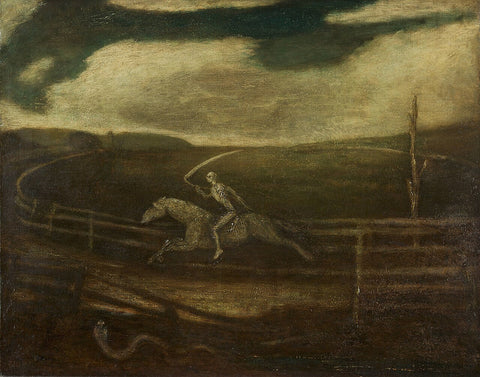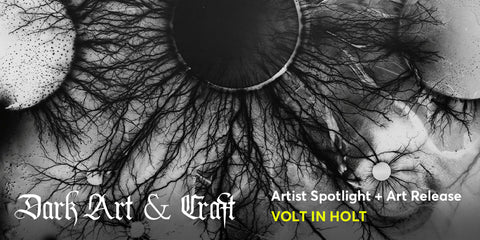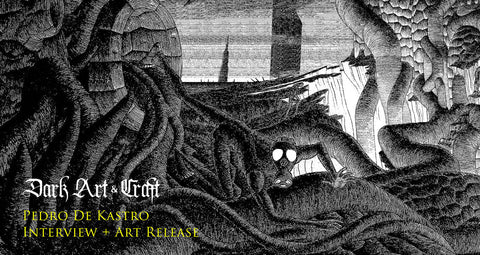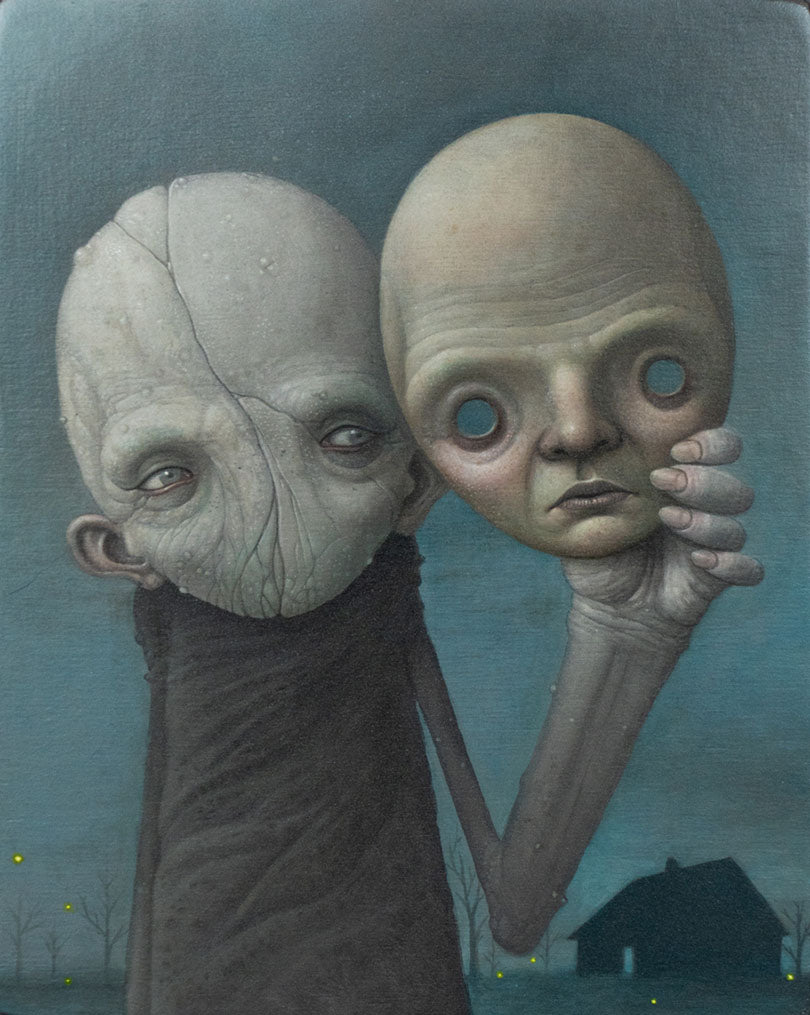
This month we are honored to be featuring the work of Seattle-based painter Ego Shoreclay online in our web store. We had the opportunity to ask him a few questions about his transition to working as a full time painter, the evolution of art galleries and his advice to other creatives looking to take their art to the next level.
I am a socially awkward extroverted introvert who creates intricately detailed acrylic paintings of creepy things.
I live and work in Seattle Washington (which, likely, affects the tone of my work. It is dark and rainy for a large portion of the year, making it seem a bit gloomy).
What does dark art mean to you?
To me the words “dark art” sound like some kind of Harry Potter evil wizard, vampire, secret society, offshoot of regular art...and, I’m secure enough in my nerdiness that I like that.
I think of dark art as the artistic expression of the things on the macabre fringe of human experience, or that have a particularly gloomy tone.
I suppose there’s no way to avoid cliché in expressing the idea that darkness is a necessary contrast to light.
I can’t remember a time when I ever wanted to be anything other than an artist.
As a young child, even when the other kids talked about their aspirations to be a firefighter, police officer, astronaut...or, even a superhero, I always stood by my choice to be an artist.
I knew I would never settle for anything else. Though I had no idea what the struggle to become a working artist would entail, I knew that nothing else would suffice.
I notice there's a lot of similar imagery in your artwork, obviously, this is a style choice but could you tell us more about what you paint? What themes, what sorts of narratives inspire your creative process?
One of the recurring themes is depictions of solitary outsiders.
Characters who on the surface may look frightening, but have a certain melancholy charm.
(Of course, this all reflects my own story, I’m sure, but let’s just continue to allow my painting to be my therapist...)
Ultimately, I hope the images speak for themselves to deliver whatever message is relevant to the viewer.
I don’t want to feel like I’m bullshitting people by ascribing some pretentious, deep, meaningful philosophy to my work.
I tend to paint a lot of skeletal, ghoulish creatures, and have been attracted to that imagery since my early teen years. I was asked by many a “grownup” why I didn’t draw “nice”things. I couldn’t understand why they couldn’t appreciate how “nice” the skulls looked that I was drawing.
I have recently come to an understanding about the imagery I choose to depict, and to that end have decided to declare that I am not obsessed with death, just aware that it is a constant.
Some of my early influences were sci-fi, horror movies, music (specifically images used to promote heavy metal and punk rock), skateboard art, and cartoons.
I also like to include esoteric symbols, and writing in less common languages.
You are part of a creative power couple. What is it like to be married to another artist?
My wife, Megon Shoreclay, is a dedicated, skillful, and creative tattooer and painter who is very passionate about all things relating to the art and craft of her work.
She was fortunate enough to be able (with a lot of help and persistence) to make a place for herself in the career she loves.
Before we came together, the creation of my art had been a private side of myself that I was very reluctant to share with romantic partners. Since we have been together, Megon and I share from each other’s perspectives and grow together as artists.
It is a rare and wonderful thing that I appreciate very much. Now, I know that all sounds pretty idyllic. Don’t get me wrong, we still disagree on plenty of occasions...but, ultimately, it is great to have a skilled professional consultant available at all times.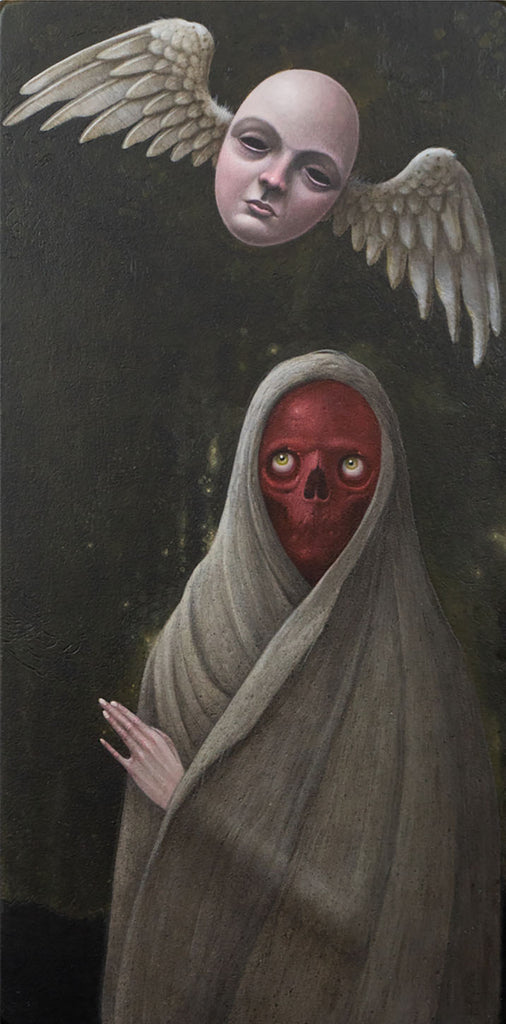
This is an especially interesting time to ask about projects on the horizon, as I have recently committed full time to my career as a professional fine artist, after having just retired from 25 years as a professional tattooer. It was a bit of an impulsive move, but I had to follow my passion. I am finding myself having to hustle extra hard to adjust to the rhythm of painting to make a living, but I am open to the challenge, and grateful to be able to do what I love.
I am happy to consider myself a part of a very supportive group of artists who have called Seattle home. Through this group I have been privileged to take advantage of many opportunities to collaborate, show, and grow my artistic practice.
The next gallery exhibition to include my art, and that of several other artists from my local scene, is a group show in Portland Oregon titled “Pareidolia”. The show is hosted by Antler and Talon galleries, and is curated by Casey Weldon.
“Pareidolia” features an exceptional lineup of artists, among which I am very pleased to be included.
I will mostly be participating in group shows for the majority of 2019, but have plans for something bigger, and more personal in October at Statix gallery, here in Seattle.
Aside from showing my work in galleries, I am also releasing a small number of prints. I am happy to say that one of these print releases will be in partnership with Dark Art And Craft.
There will also be some other commercial work of which I will provide more information as the projects come closer to fruition.
The fine art world is changing. Galleries are changing. Can you talk about how you have experienced this change and what do you like (and dislike) about some of the changes coming up? (Digitization of shows, etc.)
Early in my pursuit of fine art as a career, I believed there was no possible way to be successful and to have your art taken seriously other than showing in galleries and having those gallerists, and art dealers guiding the way.
That was before the prevalence of social media as a marketing tool for artists. Now, I often see artists who have garnered larger followings than the galleries with whom they show. So maybe digitization is the only way to keep up with that.
Don’t get me wrong...right now I still feel like there is value in brick and mortar gallery spaces as centers for mutually beneficial community building, wherein you can still go to get a close up glimpse of the details of a work of art that you just can’t appreciate by seeing it on a computer screen.
It will be interesting to see how galleries adapt to, or become overwhelmed by the proliferation of online sales, and artists being so well able to promote themselves.

You once straddled both the fine artist realm as well as the tattooer sphere. Can you tell us a little bit about how your artwork changed based on the medium?
As I mentioned previously, I have only ever wanted to be an artist. I learned in my early twenties that I could earn a living as a professional artist and obtain an invaluable skill as a tattooer.
I was initially hesitant to become a part of the world of tattooing, as I had always seen myself becoming an illustrator or fine artist. My hesitation was ultimately overcome by my stubborn desire to conquer the new medium.
I soon learned that through tattooing I would become a much more skilled illustrator. To be a well-rounded tattooer it is important to be able to draw anything. If you care enough, you research and learn about all the different things that you’re asked to draw for others; plants, animals, logos, various letterforms, the symbols of many different cultures, and more...
As I learned the technical skill of tattooing I was able to inject a bit of my own style into the work I was doing, and that began a 25-year cycle of tattooing making me a better artist, and being a better artist making my tattooing better.
There are certain images that just lend themselves better to the medium of tattooing, which I learned and tried to remember whenever creating artwork to be tattooed. Lots of very thin, or light colored lines, or small densely detailed images don’t tend to hold up over time in a tattoo, likewise very lightly colored images without a bold outline, or enough contrast will not fare well in the long run.
I was able to save my obsessively tiny detail work for my fine art.
I wasn’t always happy to be a tattooer...but, I would never underestimate the impact it had on my development as an artist. I gave my blood, sweat, and tears to tattooing, and it rewarded me with a profitable career and an unparalleled art education, as well as introducing me to some of the finest people I know.
Who inspired you as an artist?
An abbreviated (but, still pretty long) list of specific artists who have left an indelible impression on the way I create art needs to include:
Chuck Jones
Derek Riggs
Pushead
Egon Schiele
Bill Sienkiewicz
http://frankfrazetta.net/
Simon Bisley
H.R. Giger
Chris Mars
and
Zsdislaw Beksinski
(Not necessarily in that order...)
There are so many more inspirational artists who have shaped my work in some way, but those I just named were fundamental (...and, a complete list would take a very long time to compile).
What is some advice you have for people looking to pursue art as their career?
Get a “real” job!
You’ll probably be happier and live longer. Use the money and days off from your job to enjoy your art hobby... but, seriously-
Unless you’ve got the financial freedom to pursue a career as an artist, you are setting yourself up for a lifetime of uncertainty, inconsistency, and disappointment.
How’s that for a pep talk?
If you’re foolish enough to still be compelled to choose art as a career, then do it! Don’t let any obstacle stand in your way!
I’m not trying to sell anyone the fairytale that you can do anything you want if you try hard enough, that is total bullshit...but, if you just can’t imagine doing anything else, you owe it to yourself to give it a shot. It may not work out...but, at least you won’t go through life kicking yourself for never having tried.
You can find Ego online in web store but additionally on:
Instagram: @lordego1
Website:
Find a limited edition run of Ego's prints on Dark Art & Craft


